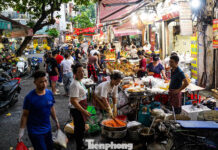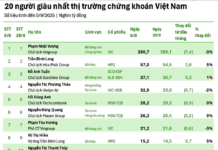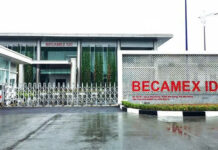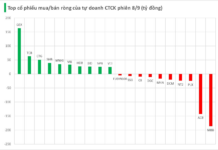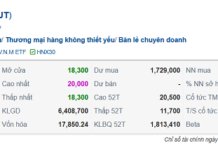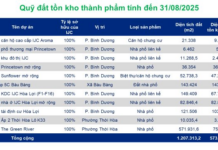Rice is a staple food for over 3.5 billion people, almost half of the world’s population, according to the FAO. There are many types of rice globally, each with its unique characteristics, thanks to constant improvements by researchers. However, one particular type of rice stands out for its unique formation and high price tag: bamboo rice.
Originating from China, bamboo rice is harvested from bamboo rice plants. According to experts at the Inspection Organization of the Ministry of Agriculture in China, bamboo rice possesses superior qualities compared to ordinary rice varieties. It is particularly rich in nutrients such as calcium, potassium, selenium, zinc, copper, and iron, containing up to tens of times more than regular rice. Additionally, it is a rich source of flavonoids, which have antioxidant, antibacterial, and anti-aging properties.

Bamboo rice plants exhibit superior traits compared to other hybrid rice varieties.
Bamboo rice also boasts medicinal value, known for its cooling, detoxifying, and blood-enriching properties. The bamboo rice plant inherits the best traits of bamboo, showcasing remarkable resilience against adverse conditions such as storms, droughts, and pests.
The Birth of Bamboo Rice

Chung Chương Mỹ, known as the “father of bamboo rice” in China.
The story of bamboo rice began in 1969 when a researcher named Chung Chương Mỹ, inspired by the success of hybrid rice created by Professor Yuan Longping, the “father of hybrid rice,” noticed bamboo flowering and conceived the idea of crossbreeding rice and bamboo. Chung Chương Mỹ is recognized as the “father of bamboo rice” in China.
Chung Chương Mỹ observed the entire process of bamboo flowering and dying. He noticed that bamboo possessed superior traits, such as resistance to lodging, drought, and cold, high yield, and pest resistance. He wondered if these traits could be transferred to rice plants.
He planted several rice and bamboo varieties close together and discovered that they could cross-pollinate naturally. Bamboo flowering is a rare occurrence, and some bamboo species take over 100 years to bloom.

Bamboo flowers blooming, a rare event that occurs once in decades for some species.

Flowers of the Fargesia nitida bamboo species, which blooms after 120 years. Photo: Shweeash Bamboo
Bamboo is one of the fastest-growing plants on Earth. According to Amusing Planet, a bamboo plant can grow up to 10 cm per day, with some species even surpassing 1 meter daily. Most bamboo species take only 5–8 years to mature.
However, bamboo is also one of the slowest flowering plants globally. For most bamboo species, the interval between flowering events is between 60 and 130 years. Strangely, after flowering and fruiting, the bamboo dies, and the entire bamboo grove withers for a few years. Experts speculate that the parent plant may sacrifice itself to make way for its offspring.
Each bamboo species has a unique flowering cycle. While some bamboo species flower every 10–20 years, rare species may have flowering cycles spanning several decades.

After nearly 40 years of persistent research and crossbreeding, Chung Chương Mỹ successfully developed the superior bamboo rice variety.
Bamboo flowering played a crucial role in creating bamboo rice. This is why Chung Chương Mỹ’s research took nearly four decades. It wasn’t until 2007 that his research on distant hybridization between rice and bamboo was approved for publication by the Science and Technology Bureau of Mei County, Guangdong Province. In 2011, a detailed study on the characteristics of bamboo rice was published.
Chung Chương Mỹ shared, “My long-cherished wish is that the world will be filled with this crop, and farmers will benefit from it.” This belief supported his decades-long dedication to bamboo rice research.
The success of creating bamboo rice gained attention when Guangdong Province exhibited this rice variety at an international exhibition in Italy in 2015. Subsequently, in 2021 and 2022, bamboo rice was officially grown in Guangdong Province and transferred to production by the Guangdong Bamboo Rice Science and Technology Company.
Why Is Bamboo Rice So Expensive?

The successful creation of bamboo rice is considered a positive step forward in improving hybrid rice varieties.
In China, bamboo rice is so rare that it is dubbed the “food of the phoenix.” A Chinese pharmacopoeia also mentions that this rice can enhance mental alertness and energize the body. However, due to its scarcity and superior qualities, bamboo rice commands a high price compared to other rice varieties.
In China, bamboo rice typically costs between 200 and 600 CNY per kilogram (approximately 700,000 to 2,100,000 VND per kilogram). The price increases for bamboo rice harvested from bamboo plants that flower only once in several decades.
Currently, the area dedicated to bamboo rice cultivation in China is still limited, mainly in Guangdong Province. However, experts believe that as the cultivation area expands, the price of bamboo rice will become more accessible.
References: FAO, Chinanews, Baijiahao, Baidu, Amusing Planet



